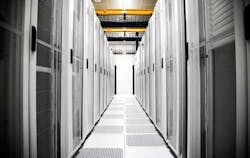NEW YORK – The Internet of Things will create millions of connected devices, generating data from homes, cars and the vast reaches of industrial infrastructure. Data will be everywhere, and many of the new digital conversations will involve machines talking to other machines. It will have major implications for infrastructure.
“It changes the way you think about the data center,” said George Slessman, the CEO of IO. “The paradigm is shifting. The traditional data center will go the way of the 8-track tape player.”
Slessman says the explosion of connected things will lead to new types of data centers in new places, optimized around the needs of machine-to-machine (M2M) workloads and the analytics that mine these oceans of data for business insights. That could include unmanned facilities placed closer to network of IoT devices, where software and analytics can make real-time adjustments to data center configuration.
“We’re going to see a broader and more important push to the edge,” said Slessman, who spoke April 20 at the DatacenterDynamics Enterprise conference in New York. “I believe the edge is where much of the interesting things will be happening. I think the next generation of data centers will be much smaller data centers, much more diversely deployed. I think you’ll see a large swath of micro-data centers deployed in these locations.”
In his work at IO and BASELAYER, Slessman has focused on enabling companies to deploy data center infrastructure wherever they need it, creating modular data centers and the software to power them. It’s always been an ambitious vision. So when Slessman speaks about a “broader and more important” trend, it provides a sense of the pending transformation of the Internet infrastructure sector.
New Technologies Reshape Our Infrastructure
This is the first in a series of stories looking at the emerging technologies that will shape the future of the data center. Machine learning and virtual reality will require unprecedented levels of computing horsepower, connectivity and data storage. As these technologies move toward the mainstream, they will likely drive major changes in IT infrastructure.
The Internet of Things could be the largest driver of transformation. It will require infrastructure in locations that have not traditionally been business markets for data centers. These technologies will be rolled out over many years, as users gradually wrap their arms around the rapidly-growing universe of protocols, applications and use cases.[clickToTweet tweet=”IO CEO George Slessman: The next generation of data centers will be much smaller and much more diversely deployed.” quote=”IO CEO George Slessman: The next generation of data centers will be much smaller and much more diversely deployed.”]
How much infrastructure will be needed to support the Internet of Things? Industry veteran Mark Thiele, Chief Strategy Officer at Apcera, recently ran an analysis.
“If the numbers follow a historical precedent at all we will need roughly 400 million servers to support our 2020 IoT and technology demands,” said Thiele. “Let’s look at what 400 million servers means to data centers. A massive data center with 5,000 racks with 20 servers per rack has 100,000 servers. In order to have enough data centers for 400 million servers we would need to add another 4,000 massive data centers measuring roughly 400K SF with approximately 50 megawatts of power each.”
That kind of growth is one thing in core markets like Northern Virginia or Silicon Valley. One of the challenges of the IoT is that it will be distributed. Building data centers in new markets is risky, replete with tough choices on how much to invest, and whether to lead boldly or wait for a critical mass of existing business.
Right-sizing for the edge will be critical in serving the new markets and applications created by the IoT. Modular design and lean construction methods are playing a major role, as data center providers seek to deploy space in digestible chunks.
How M2M Traffic is Different
Slessman says that the nature of M2M traffic presents an opportunity for design innovation. “The machine is fundamentally a different type of consumer, driven by software and defined by software,” said Slessman. “By comparison, the human is a very tough customer of IT infrastructure. The new machine consumer is going to be a much more compliant user, and can be told what to do and when to do it.”
George Slessman, the CEO io IO, speaks at the DatacenterDynamics Enterprise conference in New York. (Photo: Rich Miller)
In addition to being more manageable, machine algorithms will be less sensitive to failure, said Slessman, which allows for design flexibility in power infrastructure. “You must be able to deliver street power and concurrent maintainability in the same data center,” he said.
The trend toward variable resiliency data centers is already gaining traction with providers like Vantage Data Centers and Verne Global, which are providing data center space without backup generators or UPS support.
One of the strengths of modular data centers is the ability to compartmentalize workloads, allowing changes to be deployed 18 racks at a time. Modules and micro-modules are likely to play a leading role in edge and IoT deployments.
Slessman believes automation will be pivotal in managing IoT devices and the oceans of data they will produce. “The hybrid data center must be controlled by software, not people, with real-time telemetry and the ability to make changes to infrastructure on the fly.”
Lights Out at the Edge
What might these highly-automated data centers look like? A first step can be soon in the edge network created by EdgeConneX, which is operating unmanned “lights out” data centers in 20 markets across the United States. The EdgeConneX design is among the most ambitious uses of automation to streamline data center operations. The company has the ability to remotely control the generators and UPS systems at each facility from a central network operations center.
Cabinets inside an EdgeConneX data center. The company has built a network of data centers focused on the needs of edge content providers. (Image: EdgeConneX)
Some wonder why these distributed IoT workloads can’t just be added to existing content delivery networks. In fact, the requirements are different, according to Harmail Chatha,the Director of Global Data Center Operations at e-commerce specialist Groupon.
“The key difference is that an edge data center offers compute and management of data,” said Chatha. “Not all of that traffic needs to come back to your core data center. You can process some of that at the edge.”
“The requirement is really to run analytics closer to the source,” said David Cappuccio, an analyst at Gartner. “You’ll start seeing small data centers especially for them. We’re going to see an evolution of designs and strategies to include edge computing. We need to start thinking horizontally and think more about our end points. We tend to think vertically. In this environment, we need people who understand how all the pieces fit together.”
Wanted: A Form Factor for the Future
What’s the right timetable for thinking about the Internet of Things? Chris Crosby, CEO of Compass Datacenters, says the industry should expect an environment of continuous change over the next five to 10 years, resulting in three stratified tiers of IT infrastructure with specific functions:
- Centralized hubs serve as processing point for primary applications
- Edge data centers that perform regional processing/caching and determine what data moves upstream to the hub. Each edge facility will support one or more micro data centers
- Micro data centers deployed near workloads, serving as repositories for high-demand content and providing low latency for content and IoT data.
In this new world, Crosby says, infrastructure requirements will be determined by the location of the customer or device and the need for low-latency communications. Crosby emphasizes that these micro data centers are not glorified IT closets, but true data centers. He also dismisses the notion that edge and micro-data centers will be engineered for lower resiliency, citing the need for security in IoT applications and the capital cost of equipment. “Facilities will be mission-critical at all levels,” he said.
As data moves to the edge of the network, data centers are being right-sized to fit the demands of these new markets, built affordably and expanded in phases. Modular design and pre-fabricated construction are playing a key role in these deployments, but are being applied in a variety of ways.
Schneider Electric’s suite of modular data center products. (Image: Schneider Electric)
Schneider Electric sees micro data centers as the key for unlocking the Internet of Things.
“The use case on the horizon with the greatest potential is a massive distributed network of micro data enters to form a content distribution network,” writes Steven Carlini, Senior Director of Data Center Global Solutions for Schneider Electric. “This processing on the edge will support the commercial Internet of Things (IoT), including the fast emerging category of wearable devices. The processing of data could be reduced to milliseconds here.”
A recent research report projects that micro data centers will proliferate at the “edge” of the network, with a potential value of $6.3 billion by 2020.
About the Author



